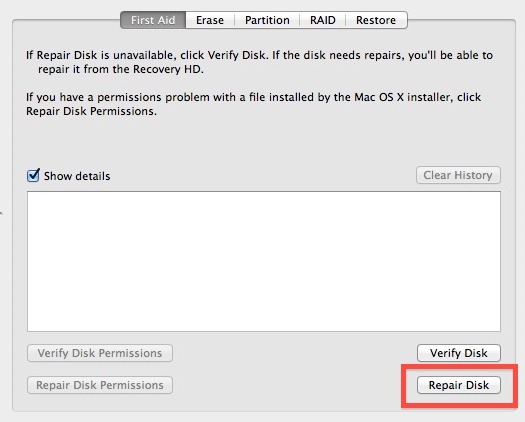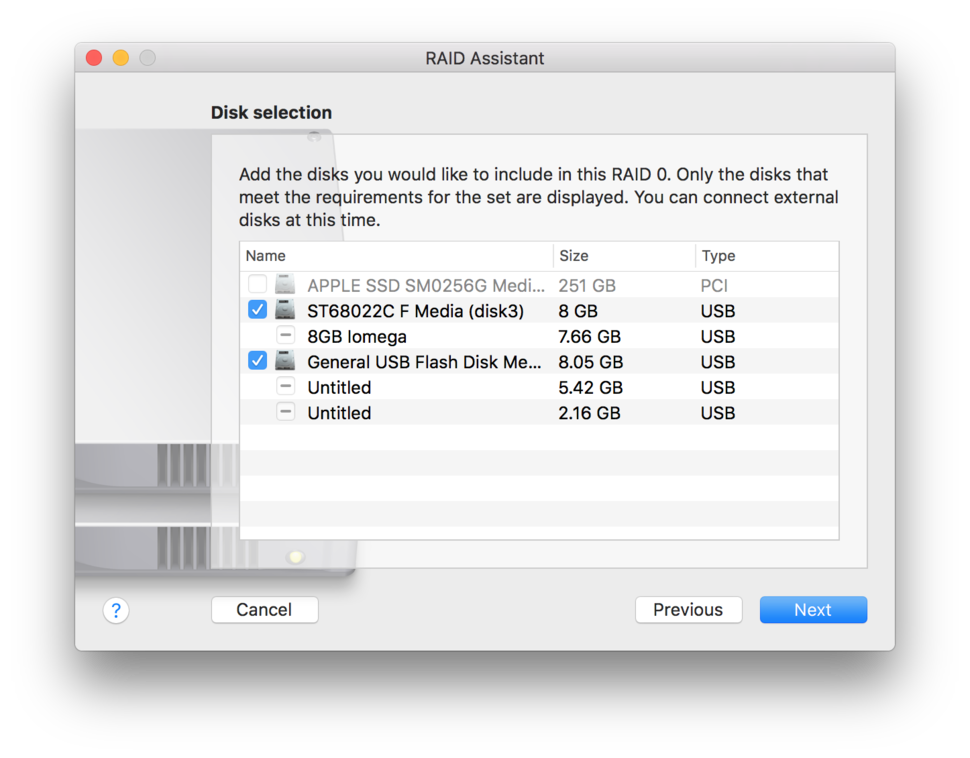RAID Utility application on a computer with a Mac Pro RAID Card or Xserve RAID Card. With a Mac Pro RAID Card or Xserve RAID Card installed in your computer, you can use RAID Utility to turn your computer’s internal disks into storage volumes based on RAID (redundant array of independent disks) schemes that improve performance. Enter a name for the JBOD RAID set that displays on the desktop. Select Mac OS Extended (Journaled) from the Volume Format dropdown menu. Select Concatenated Disk Set as the RAID type. Click the Options button then click the + button to add the JBOD RAID set to the list of RAID arrays. Jul 27, 2016 without 3rd party utilities Windows does not read Mac Extended drives and even then depending on how the RAID was built it's no guarantee that Windows will see it as a RAID. If you need to see the drive itself USING WINDOWS it should be found in. STARTAdministrative Tools/Disk Management. If not it's likley gone as well. To set up a RAID array in Mac OS X, follow these steps: From the RAID tab of Disk Utility, click and drag the disks from the list at the left to the Disk box at the right. Click the RAID Type pop-up menu to specify the type of RAID that you need. Mar 13, 2008 Support Communities / Mac OS & System Software / Mac OS X v10.5 Leopard Looks like no one’s replied in a while. Redundant Array of Inexpensive Disks. Read more about them here. A single drive does not make a RAID. Posted on Mar 13, 2008 1:27 AM. View answer in context.
RAID, Redundant Array of Independent/Inexpensive Disks, is actually what it says. In English, a RAID set is a group of multiple separate disks, working together as a team. You can set up a RAID array on your MacBook. RAID can
Improve the speed of your system
Help prevent disk errors from compromising or corrupting your data
The RAID controls within Disk Utility are shown here. (Note that the Disk Utility toolbar is turned on as well, just to show you what it looks like.)

You need at least two additional hard drives on your system besides the start-up disk, which you shouldn’t use in a RAID set.
To set up a RAID array in Mac OS X, follow these steps:
From the RAID tab of Disk Utility, click and drag the disks from the list at the left to the Disk box at the right.
Click the RAID Type pop-up menu to specify the type of RAID that you need.
Striped RAID Set: Choosing this can speed up your hard drive performance by splitting data between multiple disks.
Concatenated RAID Set: Choosing this allows several volumes (or even multiple disks) to appear as one volume within Lion.
Mirrored RAID Set: Choosing this increases the reliability of your storage by creating a mirror backup of that data across multiple disks.
Click in the RAID Set Name field and type the name for your RAID set.
From the Volume Format pop-up menu, choose a format for the volumes.
Always use Mac OS Extended or Mac OS Extended (Journaled) from the Volume Format list unless you have a specific reason to use the MS-DOS File System (for compatibility with PCs running Windows). Journaling helps reduce the amount of disk fragmentation and also helps speed up your hard drive’s performance.
Click the Create button.
Disk Utility User Guide
You can create a Redundant Array of Independent Disks (RAID) set to optimize storage performance and increase reliability in case of a disk failure. You can also create a set that concatenates smaller disks to act as one larger disk.
In the Disk Utility app on your Mac, choose File > RAID Assistant.
Select a set type:
Striped (RAID 0) set: A striped RAID set can speed up access to your data. You can’t create a RAID set on your startup disk; you must first start up your computer from another disk.
Mirrored (RAID 1) set: Protect your data against hardware failure with a mirrored RAID set. When you create a mirrored RAID set, your data is written to multiple disks so the information is stored redundantly. You can’t create a RAID set on your startup disk; you must first start up your computer from another disk.
Concatenated (JBOD) set: Increase storage space with a concatenated disk set. If you need one large disk, but you have several smaller disks, you can create a concatenated disk set to use as one large disk.
Select the checkboxes of the disks you want to include in the set.
For each disk, click the pop-up menu in the Role column and choose “RAID slice” or “Spare” to designate the disk as a standard member or spare in the set, then click Next.
Enter a name for the RAID set in the RAID Name field.
Click the Format pop-up menu, then choose a volume format that you want for all the disks in the set. (See File system formats available in Disk Utility.)
Click the “Chunk size” pop-up menu, then choose a disk chunk size that you want used for all the disks.
When you create a striped set, chunks of data from the same file are distributed across the drives. Ideally, you want data distributed across drives evenly and at an optimum size so that it can be efficiently accessed. If you want high data throughput from your set, choose a smaller chunk size so that data is spread across the drives and one drive can be accessing data while another is seeking the next chunk. With mirrored disk sets, choose a chunk size that matches the data you’re accessing. For example, when working with video files, your Mac is accessing large chunks of data, whereas when using a database of many small records, your disks may be accessing smaller chunks of information.
If you are creating a mirrored RAID set, select the “Automatically rebuild” checkbox to allow the set to be automatically rebuilt when member disks are reconnected.
Click Create.
Click Done.


If you have a Mac Pro with a Mac Pro RAID card, use RAID Utility. It uses the RAID card for better performance and to create more types of RAID sets.